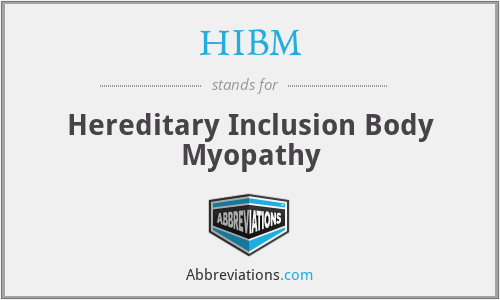What does HIBM mean in Unclassified?
This page is about the meanings of the acronym/abbreviation/shorthand HIBM in the Miscellaneous field in general and in the Unclassified terminology in particular.
Hereditary Inclusion Body Myopathy
Translation
Find a translation for Hereditary Inclusion Body Myopathy in other languages:
Select another language:
- - Select -
- 简体中文 (Chinese - Simplified)
- 繁體中文 (Chinese - Traditional)
- Español (Spanish)
- Esperanto (Esperanto)
- 日本語 (Japanese)
- Português (Portuguese)
- Deutsch (German)
- العربية (Arabic)
- Français (French)
- Русский (Russian)
- ಕನ್ನಡ (Kannada)
- 한국어 (Korean)
- עברית (Hebrew)
- Gaeilge (Irish)
- Українська (Ukrainian)
- اردو (Urdu)
- Magyar (Hungarian)
- मानक हिन्दी (Hindi)
- Indonesia (Indonesian)
- Italiano (Italian)
- தமிழ் (Tamil)
- Türkçe (Turkish)
- తెలుగు (Telugu)
- ภาษาไทย (Thai)
- Tiếng Việt (Vietnamese)
- Čeština (Czech)
- Polski (Polish)
- Bahasa Indonesia (Indonesian)
- Românește (Romanian)
- Nederlands (Dutch)
- Ελληνικά (Greek)
- Latinum (Latin)
- Svenska (Swedish)
- Dansk (Danish)
- Suomi (Finnish)
- فارسی (Persian)
- ייִדיש (Yiddish)
- հայերեն (Armenian)
- Norsk (Norwegian)
- English (English)
Definition
What does HIBM mean?
- Hereditary inclusion body myopathy
- Hereditary inclusion body myopathies (HIBM) are a group of rare genetic disorders which have different symptoms. Generally, they are neuromuscular disorders characterized by muscle weakness developing in young adults. Hereditary inclusion body myopathies comprise both autosomal recessive and autosomal dominant muscle disorders that have a variable expression (phenotype) in individuals, but all share similar structural features in the muscles. HIBMs are a group of muscle wasting disorders, which are uncommon in the general world population. One autosomal recessive form of HIBM is known as IBM2 or GNE myopathy, which is a common genetic disorder amongst people of Iranian Jewish descent. IBM2 has also been identified in other minorities throughout the world, including people of Asian (Japanese and others), European, and South American origin, as well as Muslim people in the Middle Eastern, Palestinian, and Iranian origin. In Japan and many East Asian countries, this disorder is known as Distal Myopathy with Rimmed Vacuoles (DMRV). IBM2 causes progressive muscle weakness and wasting. Muscle wasting usually starts around the age of 20 – 30 years, although young onset at 17 and old onset at 52 has been recorded. As such, it affects the most productive times of our lives. It can progress to marked disability within 10 to 15 years, confining many people with IBM2 to a wheelchair. The weakness and severity can vary from person to person. In some, weakness in the legs is noticed first. In few others, the hands are weakened more rapidly than the legs. Weakness is progressive, which means the muscle becomes weaker over time. IBM2 does not seem to affect the brain, internal organs or sensation. The quadriceps are relatively spared, and remain strong until the late stages of disease, which is the reason IBM2 is often referred to as Quadriceps Sparing Myopathy (QSM).
Embed
Citation
Use the citation below to add this abbreviation to your bibliography:
Style:MLAChicagoAPA
"HIBM." Abbreviations.com. STANDS4 LLC, 2024. Web. 25 Apr. 2024. <https://www.abbreviations.com/term/1656126>.



Discuss this HIBM abbreviation with the community:
Report Comment
We're doing our best to make sure our content is useful, accurate and safe.
If by any chance you spot an inappropriate comment while navigating through our website please use this form to let us know, and we'll take care of it shortly.
Attachment
You need to be logged in to favorite.
Log In